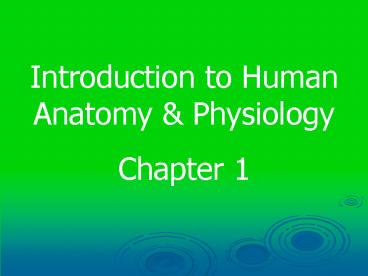Introduction to Human Anatomy - PowerPoint PPT Presentation
1 / 51
Title:
Introduction to Human Anatomy
Description:
Introduction to Human Anatomy & Physiology Chapter 1 Endocrine System Includes all glands that secrete chemical messages called Hormones (they travel in fluid ... – PowerPoint PPT presentation
Number of Views:139
Avg rating:3.0/5.0
Title: Introduction to Human Anatomy
1
Introduction to Human Anatomy
Physiology Chapter 1
2
Anatomy The branch of science that deals with the
structure of body parts Their forms and
arrangements
3
Physiology Deals with the functions of body
parts What they do and how
4
Human Organism A well-organized unit of body parts
5
Characteristics of Life (10) Movement Self-initi
ated change in position
6
Responsiveness The ability to sense changes and
react Growth An increase in body size
7
Reproduction Respiration Obtaining oxygen and
using it in the release of energy from food
8
Digestion Food chemically changed into forms
that can be absorbed by the body
9
Absorption The passage of substances through
membranes Circulation Movement of body fluids
10
Assimilation Changing absorbed substances into
forms that are chemically different from those
that entered the body fluids
11
Excretion Removal of wastes that are produced by
body parts
12
Metabolism Physical and chemical changes in the
body
13
Maintenance of Life Organisms need Water (the
most abundant substance in the body), food,
oxygen, heat, pressure
14
Homeostasis The ability to maintain a stable
internal environment Ex. shivering, goose bumps,
sweat, etc.
15
Levels of Organization Small to large Atoms,
molecules, macromolecules, organelle, cell,
tissue, organ, system, organism
16
Body Divisions Axial Portion Head, neck and
trunk Appendicular Portion Arms and legs
17
Body Cavities Cavity A natural hollow place
within the body Page 8 Figure 1.6 Page 9
Figure 1.7
18
2 Major Cavities Within the Axial
Portion Dorsal Ventral Cavities
19
Dorsal Cavity Can be divided into 2
cavities Cranial-houses brain Spinal-spinal cord
20
Ventral Cavity Divided into 2 cavities Thoracic-c
hest Abdominopelvic-abdomen, pelvis
21
Small Head Cavities Oral- teeth,
tongue Nasal-right, left nose Orbital-eyes Middle
Ear-bones
22
Membrane A thin, soft, pliable layer of
tissue Parietal Pleura Membrane that lines the
thoracic compartments
23
Visceral Pleura Membrane that lines the lungs
24
Mediastinum Separates the thoracic cavity into 2
compartments The compartments contain right
left lungs
25
Pericardial Membrane Surrounds the
heart Peritoneal Membrane The lining membranes of
the abdominopelvic cavity
26
Organ Systems Humans consist of several organ
systems Made up of organs that work together to
provide a specialized function
27
Integumentary System Includes skin, hair, nails,
sweat glands, sebaceous glands
28
These parts protect underlying tissues and help
regulate body temperature. They also house
sensory receptors
29
Skeletal System Consists of bones as well as
ligaments and cartilage Serve as attachments for
muscles Provide protection/support
30
Tissues within bones produce blood cells Muscular
System Muscles are the organs of this system
31
By contracting and pulling their ends together,
they provide the forces that cause body
movements posture, body heat
32
Nervous System Includes the brain, spinal cord,
nerves, and sense organs
33
Nerve cells use chemical signals (nerve
impulses) to communicate with each other
34
Endocrine System Includes all glands that secrete
chemical messages called Hormones (they travel
in fluid)
35
Includes the pituitary, thyroid, parathyroid,
adrenal, pineal, thymus glands, pancreas,
ovaries, testes
36
The endocrine and nervous systems integrate and
coordinate to allow the body to act as a unit
37
Digestive System Receives food from
outside Converts to useful simpler molecules to
be absorbed passed on
38
Includes the Mouth, tongue, teeth, salivary
glands, pharynx, esophagus, stomach, liver,
gallbladder, pancreas, small and large intestines
39
Respiratory System Provide intake and output of
air for the exchanges of gases between blood and
air
40
Includes the nasal cavity, pharynx, larynx,
trachea, bronchi/lungs
41
Circulatory System Its a muscular pump that
forces blood through vessels Blood transports
gases, nutrients, hormones, and wastes
42
Includes the heart, arteries, veins, capillaries,
blood
43
Lymphatic System Carries fluid Includes lymphatic
vessels, lymph fluid, lymph nodes, thymus gland,
spleen
44
Lymphatic organs also aid the body in defending
the body against infections by removing
microorganisms from tissue fluids (WBCs)
45
Lymphocytes Cells of the lymphatic system
46
Urinary System Maintains water, electrolyte
and acid-base balances (kidneys) Includes the
kidneys, ureters, urinary bladder, urethra
47
Reproductive System Process of producing
offspring (progeny) Male produces/maintains sex
cells (sperm)
48
Includes the scrotum, testes, epididymides, vas
deferens, seminal vesicles, prostate glands,
penis, urethra
49
Female Provide support and development of embryo
and functions in birth process Produce/maintain
sex cells (eggs)
50
Includes the ovaries, uterine tubes, uterus,
vagina, clitoris, vulva
51
Handout on Relative Position!































